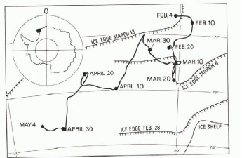A data collection platform was placed near the centre of a 950 m x 800 m near-rectangular iceberg in the Weddell Sea on 4 February 1979. Meteorological conditions and the dynamic behaviour of the iceberg were recorded for every three hours over a one-year period. The following parameters were measured: barometric pressure, wind speed and direction, air and snow temperatures, and iceberg heading, tilt, and strain. Platform elevation was 35 m a.s.l. corresponding to an iceberg thickness of about 210 m. The platform was deployed at lat. 70°5'S., long. 20°3'W, Figure 1 shows the iceberg drift and sea-ice conditions between 4 February and 4 May 1979.

Fig. 1.
Drift track of the iceberg for the period 4 February to 4 May 1979. The berg was surrounded by pack ice from about 6 March.

The tilt sensor was a Singer-Kearfott bubble-type two-axis electrolytic vertical sensing element mounted on a levelling platform. This was fixed on a 2.2 m long, 0.16 m diameter white-painted tube, which was tightly placed in a vertical drill hole in the firn, and frozen in by the addition of water (firn temperature was -5°C). The tilt sensor was level with the snow surface, and aligned so that tilt was measured along and across the main axis of the iceberg. The range of the tilt sensor was ±4.4 x 10-3 rad with a resolution of 3.7 x 10-5 rad (Bø and others 1979). The strain-meter consisted of a 1 m invar rod fixed at the passive end of the instrument to a mounting block and plate, and at the active end to the core of a linear variable differential transformer (LVDT), The LVDT body was mounted in a cage connected to a rezeroing system. The strainmeter was placed in a 1.1 m deep pit and fixed to vertical wooden posts placed 2 m deeper and frozen in. The range of the strainmeter was 1.2 x 10-3 and the resolution 10-7 (Bø and others 1979).
Tilt and strain were sampled 20 times at intervals of 6 sec. This measuring sequence was repeated every three hours. The data were stored and transmitted over the TIROS-N/NOAA satellite, which provided approximately 13 passes per day for transmission of data. Eight of these gave the location of the iceberg. Analysis has been carried out of the tilt and strain data from the instrumented iceberg for the period 4 Fébruary to 4 May 1979.